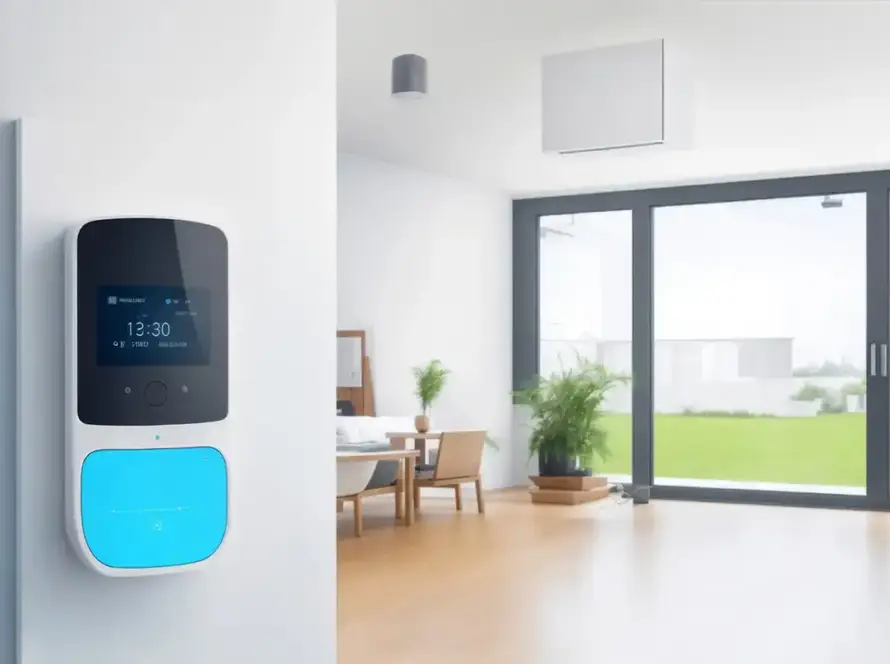We typically don’t think about how to adjust PVC windows because we’re not aware of the need for it or even the possibility. In reality, modern window frames allow for adjusting the window sash’s pressure and position. In this text, we’ll explain why adjusting plastic windows is necessary, how adjustment mistakes manifest, and how to adjust PVC windows on your own.
- Adjusting plastic windows involves regulating the window’s tightness (summer-winter adjustment) and the position of the sash.
- Self-adjusting the window’s tightness should be done before summer and winter. At that time, we should set the window’s pressure according to the outside temperature.
- The window hardware should be adjusted, for instance, when you notice drafts, damage to the seals, or difficulties in opening/closing the window.
- You can adjust the window sash yourself or with the help of a professional. Keep in mind that adjusting the hinges is a delicate process, where precision is more important than force.
- Heavily damaged and worn-out windows can’t be fixed by adjustment alone. Sometimes, replacement is necessary, which we discuss step-by-step in our blog post.
PVC Window Adjustment – The Basics
Window Adjustment is Normal
Adjusting a window sash should be as natural to us as leveling a fridge or washing machine. Any improperly positioned appliance or device will not function correctly and could even face damage. The same applies to windows.
Types of Adjustments: Position and Tightness/Pressure
In practice, there are two types of adjustments for PVC windows:
- Sash position adjustment
- Window tightness adjustment.
The first adjustment is done by the installer. Proper window adjustment requires setting them up correctly in the space where they will operate. Over time, however, a window may become misaligned, but there’s nothing stopping you from adjusting it yourself to restore it to perfect condition.
On the other hand, adjusting the window’s tightness is related to external conditions. This is often referred to as the summer-winter adjustment, as different pressure is needed in the summer compared to the winter. We’ll elaborate on this shortly.
When to Adjust the Window Sash?
As mentioned earlier, the window sash must be adjusted for the first time right after installation. The installers will take care of this for you. However, ongoing regular adjustments will be your responsibility. Ideally, this should be done twice a year: in the spring and autumn.
Adjusting Windows for Winter and Summer
Sash Pressure Adjustment: A Response to Temperature Changes
Most of the time, you’ll adjust your windows because of changing outdoor temperatures, aiming for optimal thermal insulation while maintaining proper air circulation.
Don’t worry, it only sounds complicated.
Modern, airtight PVC windows provide a strong sash-to-frame seal, preventing cold air from entering during the colder months. However, in warmer weather, we prefer better air circulation and don’t need to be as sealed off from the outside. Window manufacturers anticipated these needs and created simple mechanisms for adjusting window hardware according to the season.
Step-by-Step Guide to Adjusting Window Pressure
Now that we know why and when to adjust the sash pressure, it’s time to learn how to adjust the window pressure yourself.
Here’s how to switch from the “summer” to “winter” position:
- Locate the adjustment rollers/pins: These are found around the window sash, usually near the handle and on the opposite side. They may be oval or round with a notch.
- Check the current setting: The rollers/pins usually have markings for “summer” and “winter” (e.g., a dot or line). If the marking is facing inward, this indicates the “summer” position (less pressure).
- Adjust the rollers/pins: Using an Allen key or pliers (depending on the type of roller/pin), turn them so that the marking points outward. This is the “winter” setting (more pressure).
- Check the pressure: Close the window and make sure the sash is tightly pressed against the frame all around.
Important Notes:
- Switch from the “summer” to the “winter” position before the cold sets in, and back to “summer” in the spring to ensure good ventilation in warmer months.
- Some PVC windows may have a different pressure adjustment system. In such cases, consult the window’s user manual or the manufacturer.
- Excessive pressure in the “winter” position may make the window harder to open and close, and could cause the seals to wear out more quickly.
It’s not as intimidating as it seems, but if you’re not confident, you can always ask a handy friend for help or hire a professional.
Adjusting PVC Windows for Proper Positioning
How Do You Know if a Window is Misaligned?
Seasonal adjustment of plastic windows for tightness is one thing. Another important aspect is the periodic adjustment of the window’s positioning. Especially with older windows, the sash may shift relative to the frame, leading to various issues. There are several warning signs that should alert us.
Operational Difficulties:
- Resistance when opening and closing the window, or when it jams or sticks, is often due to misalignment, indicating the need for adjustment.
- Spontaneous opening or closing, including failure to stay in the tilt position, can have multiple causes, but one of them is incorrect adjustment of the PVC window that needs correction.
- A stiff handle is usually one of the first signs that the window sash needs adjusting. Though the issue may not be serious yet, it’s a sign the problem is beginning.
Tightness Issues:
- You should adjust your PVC window if, despite being closed, you feel air movement (adjustment alone may not be enough, but it’s a first step).
- Condensation on the glass is natural and can be minimized with warm edge spacers and better room ventilation, but if the issue suddenly worsens, window hardware adjustment may be necessary.
- PVC windows, especially double-pane ones, should block outside noise effectively. If they no longer do so, the sash likely needs adjustment.
Visible Damage and Wear:
- Scratches on the frame or sash usually indicate improper contact between these elements, meaning window adjustment is necessary.
- Modern TPE or EPDM seals are durable, especially with basic maintenance, so if they crack or deform, it’s a sign to adjust the windows sooner rather than later.
This list of potential problems isn’t exhaustive but covers most cases. It’s important to remember that adjusting old, heavily damaged, or worn windows may not provide sufficient results, and simply adjusting the window may not fully resolve the issue.
Post-Installation and Periodic PVC Window Adjustment
The first self-adjustment of PVC windows, specifically to alter the sash position, should occur about 18 months after installation—or earlier if you notice any of the above issues. In rare cases, the installation may have been faulty from the start. Fortunately, this is uncommon.
This corrective adjustment is needed because windows settle into the openings they are installed in. Large windows may also experience slight warping.
Adjusting windows should be treated like checking a car’s fluid levels—something done regularly for peace of mind and to prevent bigger problems.
How Often Should You Adjust Your Windows’ Position? Typically, checking once a year to see if an adjustment is needed is sufficient. In fact, many window owners may never need to perform extensive hardware adjustments.
How to Adjust PVC Windows Vertically and Horizontally – Step-by-Step
Window positioning adjustment mainly involves adjusting the window hinges. This allows for both vertical and horizontal adjustments. Improving the window’s position also impacts the sash’s tightness, as incorrect alignment can prevent proper sealing.
Remember, winter-summer adjustments will not be effective if vertical positioning is incorrect.
The hinge adjustment process may vary slightly depending on the window manufacturer and model, but the general principles remain the same.
Preparation:
- Open the window: Open the window to gain easy access to its hardware.
- Locate the adjustment screws: PVC window hinges typically have three adjustment screws:
- Bottom screw: Adjusts the sash height.
- Side screw: Adjusts the sash’s pressure against the frame on the hinge side.
- Top screw: Adjusts the sash’s pressure against the frame in the upper part.
- Prepare your tools: Most hinges require a 4mm Allen key for adjustment.
Adjustment:
- Vertical Adjustment (Up/Down):
- If the sash is sagging, turn the bottom screw clockwise to raise the sash.
- If the sash is too high, turn the bottom screw counterclockwise to lower it.
- Horizontal Adjustment (Pressure on Hinges):
- If the sash rubs against the frame on the hinge side, turn the side screw clockwise to increase pressure.
- If the sash is pressed too tightly, turn the side screw counterclockwise to reduce the pressure.
- Top Pressure Adjustment:
- If the sash is pulling away from the frame at the top, turn the top screw clockwise to increase pressure.
- If the sash is too tightly pressed at the top, turn the top screw counterclockwise to reduce pressure.
Verifying Adjustment: Once you’ve completed the adjustment, open and close the window several times to ensure it moves smoothly and that the sash is properly aligned with the frame. If the window isn’t operating smoothly or the pressure is incorrect, revisit the vertical adjustment.
Important Note:
Adjusting tilt-and-turn PVC windows is a delicate process that should be done carefully and slowly. Although hardware damage isn’t common, it can happen. If you’re unsure how to adjust the height of your PVC window, it’s better to consult a specialist.
Ready to Adjust Your Windows? Let’s Get Started!
We hope that our window adjustment instructions will make the annual maintenance of your windows hassle-free. The step-by-step guidance provided here is designed to help you follow a simple path to success.
It’s important to remember that PVC window adjustment is often unnecessary—you just need to check that everything is in good working order. In most cases, the only regular adjustment is switching between the summer and winter settings. Even this can be skipped if you’re not experiencing any discomfort with the current setup.
There are various systems on the market, and newer generations of windows have minor differences in their design. This means that, depending on the model, you might need an Allen key, pliers, or even a screwdriver to adjust your PVC windows. However, the basic principles remain the same.
Lastly, as we’ve mentioned before, if you’re not confident about adjusting the windows yourself, many window installers and service providers offer professional adjustment services. You can easily find them using our distributor map.
Good luck!



